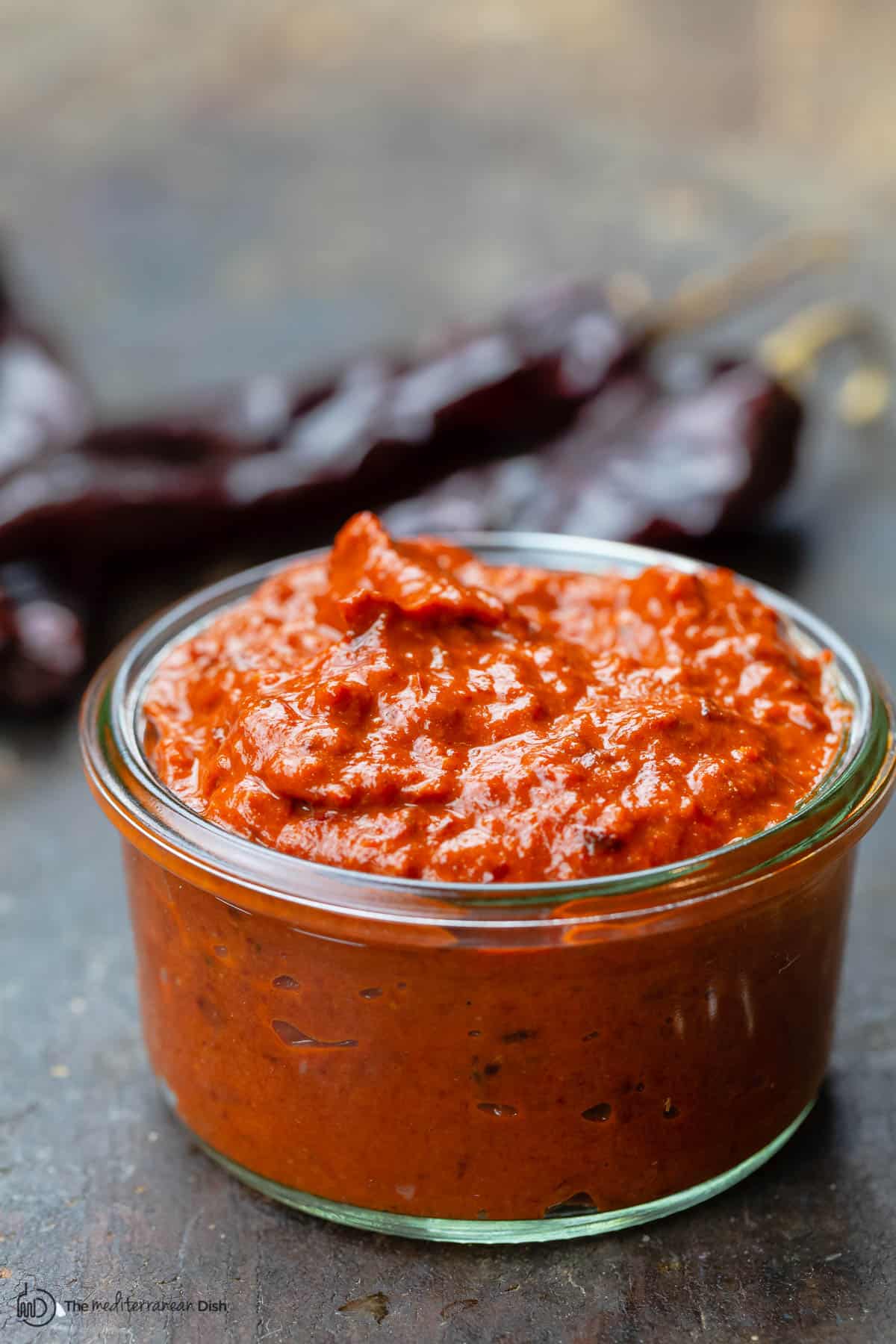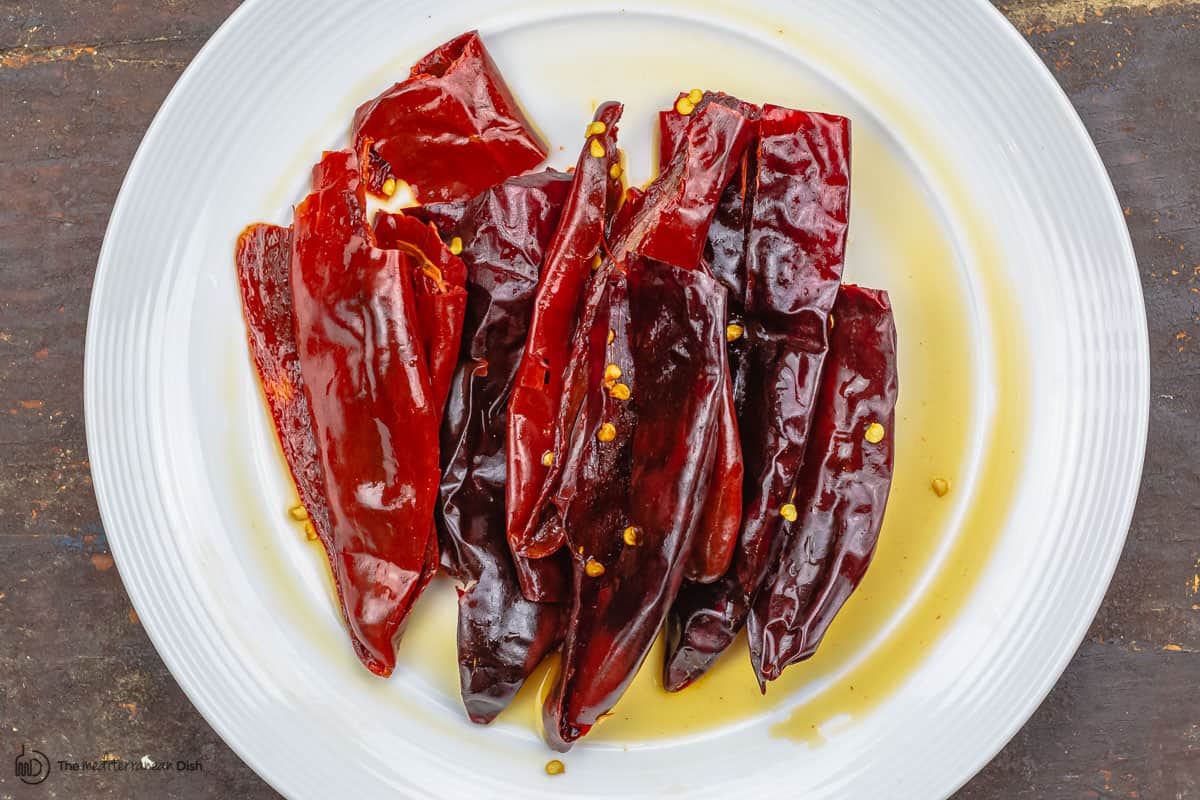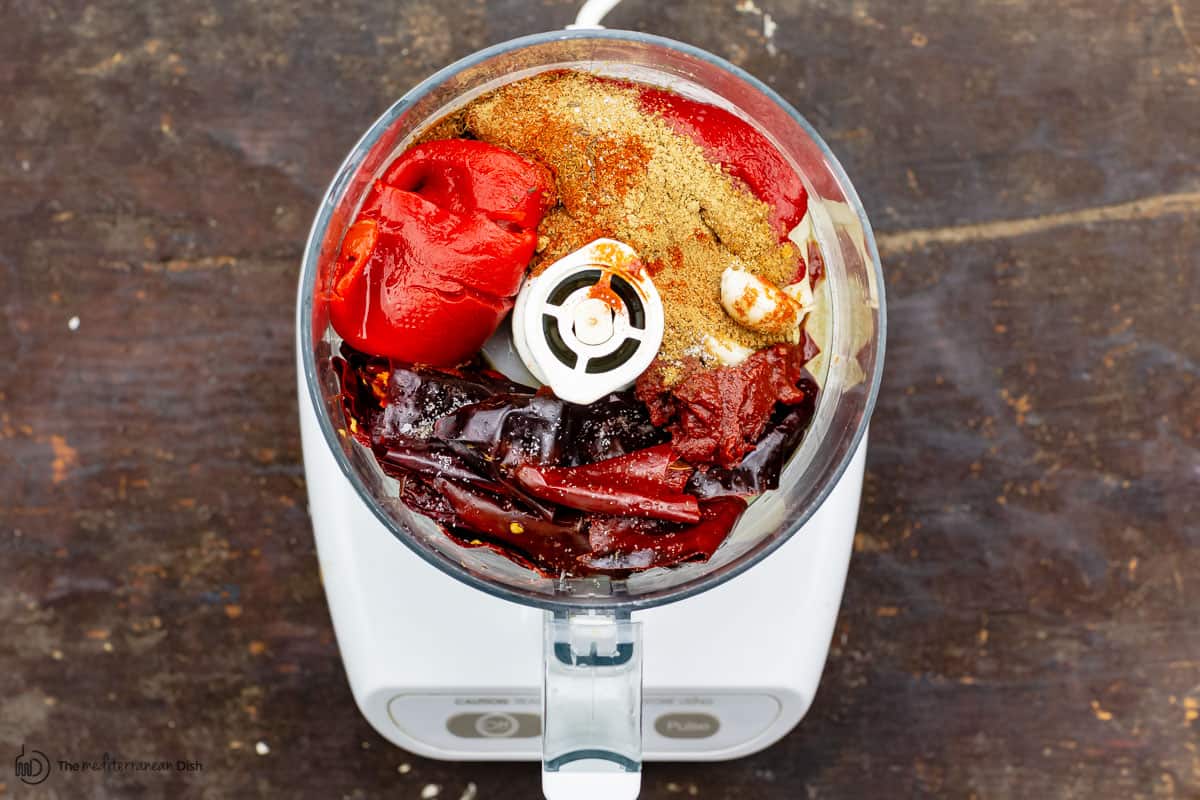Harissa is a North African red chile paste or sauce made of a few simple ingredients including chiles, garlic, olive oil, citrus and a few warm spices.
This versatile harissa recipe is slightly sweet, smoky, tangy, and just enough spicy but not too hot. Make it ahead and use in many ways! Be sure to watch the video below.

You’ve seen me use harissa spice blend in different recipes, but today we’re going to chat about harissa sauce! This, along with my earlier toum garlic sauce, belong under versatile Mediterranean dips and condiments you’ll find yourself using over and over again!
What is harissa?
I’ve heard people describe harissa as the ketchup or sriracha of North Africa and the Middle East.
It may be a red condiment that is as popular as ketchup because of the many way it is used and enjoyed. But comparing the two does not do harissa justice. Harissa is much more complex in flavor and all together addictive!
Originally from Tunisia, harissa is a chile sauce or paste typically made of dry red chiles, garlic, citrus, extra virgin olive oil and a few warm spices including cumin, coriander and caraway seeds.
And although you can find it at specialty grocery stores sold in jars or tins, homemade harissa is a completely different experience.
What does it taste like? This harissa sauce recipe is mild with just enough kick, sweet, smoky, and a little bit tangy. Absolutely addictive!
Making harissa at home is easier than most people think; be sure to watch the video below.

What kind of chiles to use for harissa?
Each batch of homemade harissa sauce may taste slightly different than the other, depending on the kind of chiles used. And as a result, some can be fairly hot, while others are mild.
You can pretty much make harissa out of any dried red chile according to your own personal heat index.
Because I like to control the heat factor in my harissa paste, I like the idea of using New Mexico chiles, which are milder but offer enough of a kick (Cookbook author Paula Wolfert believes that Gujaillo and New Mexico chiles are closest to the peppers of Nabeul and Gabès in Tunisia).
You can absolutely use a combination of chile peppers. Need more heat? Add a couple of de arbol peppers. If you like a bit of smokiness, add chipotle chile.

What you need to make it:
When I tested my harissa paste recipe, it was important for me to find the perfect balance of spicy, sweet, smoky, and tangy all in one red chile paste, and the following ingredients did just that:
- Dry red chiles (7 whole chiles). I prefer New Mexico chiles or Guajillo chiles which are milder (this allows me to add more heat as needed).
- Roasted red peppers (6 ounces or 2 large roasted red peppers). Jarred peppers will work here, just drain them well. These will add sweetness and also support the texture of the harissa paste.
- Tomato paste (2 tablespoons or so) for the umami factor.
- Fresh garlic cloves. I usually use 4 cloves, but if you enjoy more garlic, go for it!
- Spices. A combination of North African flavors from 2 teaspoons each coriander and cumin; 1 teaspoon caraway seeds toasted and ground (use a mortar and pestle, grinder, or food processor); 1 teaspoon smoked paprika (this adds depth and smokiness without adding more spice). I also use a pinch of cayenne pepper; start with 1/2 teaspoon and go from there.
- Kosher salt
- Citrus. Juice of 1 large lemon (do not skip this as it adds brightness and rounds out flavor).
- Extra virgin olive oil. This is drizzled into the food processor as the rest of the ingredients are mixing together. Use a quality EVOO that you enjoy; I used Early Harvest Greek EVOO.
How to make harissa
Making harissa at home could not be simpler!
First, you’ll soak the dry red chiles (whatever combination of chile peppers you selected) in hot water to rehydrate. If you don’t rehydrate them, you can’t exactly turn them into paste.

From there, seed the chiles and blend them in a food processor with the roasted red peppers, garlic, tomato paste, spices, and lemon juice.

Drizzle the extra virgin olive oil as the ingredients are mixing until you arrive at a beautiful, slightly chunky paste. That’s it!

It’s even better the next day!
You can use harissa sauce as soon as you make it, but if you refrigerate it and use it the next day or two, the flavors will meld well and create a much deeper chile paste you’ll love!
Storage
I like to store my homemade harissa in the fridge in a tight lid mason jar. Adding a drizzle of extra virgin olive oil on top will help seal it well. It typically lasts 2 to 3 weeks in the fridge.
You can also freeze it for later use (about a month or so).
Ways to use harissa
Once you make harissa paste at home, you’ll find yourself using it in many different ways. Here are a few ideas:
- One of my favorite ways to use it is in this harissa chicken recipe. But it’s also great to season fish, fish kofta, or vegetables for grilling or baking. I also love the heat it brings to my Chicken Kofta Kebabs with Garlic-Mint Yogurt.
- Add a couple tablespoons of your homemade harissa to a soup like this red lentil soup or Moroccan vegetable stew or lamb stew. Or add some to your shakshuka for a little kick!
- Stir it in your hummus to add a kick or as a topping to your chicken kofta or lamb burger in place of Tzatziki.
- Use on scrambled eggs just like hot sauce, or whisk it into your Tunisian-style frittata.
Browse all recipes here. Join my free e-mail list
Easy Harissa Recipe

Equipment
- Food processor
Ingredients
- 7 Dried New Mexico Chiles or Guajillo Chiles, or a combination of dried New Mexico Chiles and another kind of dried hot chiles such as de arbol or chipotle chiles
- 6 oz jarred roasted red peppers, drained rinsed, and dried (2 large peppers)
- 2 tbsp tomato paste
- 4 large garlic cloves, peeled
- 1 tsp caraway seeds, toasted and ground (use a mortar and pestle, grinder or food processor)
- 2 tsp ground coriander
- 2 tsp ground cumin
- 1 tsp smoked paprika
- ½ tsp cayenne pepper
- Kosher salt
- Juice of 1 large lemon, 2 tbsp fresh lemon juice
- 2 tbsp quality extra virgin olive oil, more for later
Instructions
- Soak and prepare the dried chiles. Place the dried chiles in a heat-safe bowl and cover with hot water. Set aside for 30 minutes until the chiles are tender and re-hydrated. Drain the chiles and remove the stems and seeds.
- Combine chiles with the remaining ingredients. Transfer the chiles to the bowl of a large food processor fitted with a blade. Add the tomato paste, roasted red peppers, garlic, ground caraway seeds, coriander, cumin, smoked paprika, cayenne (if using), and a large pinch of kosher salt. Add fresh lemon juice.
- Make the harissa paste. Run the food processor, and while it’s running, drizzle the extra virgin olive oil from the top opening. Stop the processor to scrape down the sides and run again until you reach the desired paste-like texture. Taste and adjust seasonings to your liking (remember that harissa paste will deepen in flavor as it sits in the fridge over the next day or two).
- Store. Transfer the harissa paste to a clean mason jar. Cover with a very thin layer of extra virgin olive oil, then cover the jar with its lid tightly and refrigerate.
Video
Notes
- This recipe makes about 1 1/2 cups of harissa paste. A serving size is 2 tablespoons.
- Cook’s Tip: You can use this homemade harissa paste as soon as you make it, but for best flavor allow it at least 1 to 2 days in the fridge.
- Storage: Homemade harissa can last in the fridge for 2 to 3 weeks, properly stored in a covered mason jar and the top the harissa paste covered with a thin layer of extra virgin olive oil. You can use a little bit of the harissa paste at a time, but be sure to add a bit more extra virgin olive oil to cover the top before storing in the fridge again.
- Can you freeze it? Yes! You can freeze harissa paste for up to 1 month or so. Best to freeze individual smaller portions.
- Visit Our Shop to browse quality Mediterranean ingredients, including spices and extra virgin olive oil used in this recipe.



I have a beautiful, freshly harvested crop of baklouti peppers that I grew in my garden from seeds. Can I use those instead of the New Mexico peppers? They are fresh, so I don’t think I need to soak them, but can you advise?
Hi, Monica. I’m sure you could probably use them, but it’s not something we’ve tried before, so it’s hard to advise here. If you do give it a go, please stop back and share your thoughts!
Super easy to make and adjust for smaller amount. Delicious!
Will freeze the excess to see if it works well the next dish.
Hi
I use so much harissa and want to make my own but I grow my own chilli’s and pepper, how would you adjust this recipe for fresh rather than dried chilli’s?
Thank You
Hi, Daphne. We’ve never tried this recipe with fresh chilies, so it’s hard to say what adaptations would have to be made. If you decide to give it a go, please stop back and share your thoughts!
I follow a low fodmap diet due to some GI issues. Substitute the garlic and olive oil with garlic infused olive oil. This sauce has made so many dishes come to life for me.
Thanks so much for sharing, David!
Can harissa be canned?
It tasted amazing!!! Thank you ☺️
I’ve worked with lots of dried chilies. Skins vary widely. Some, such as ancho are soft and puree without leaving those papery shards. Some simply won’t puree.
Just as the skins,, the flesh varies. Sometimes you can easily scrape the inside. Sometimes pushing your thumb into the flesh separates it from the skin.
Experiment. I find separating skin from flesh before blending preferable to sieving.
Is this recipe really hot? I’m sure you can use different peppers to achieve the heat degree you prefer, right? It sounds great.
Hi, Deidre. This particular version is on the milder end of the harissa spectrum. Yes, you can vary the type of peppers use to control the heat. Hope you give the recipe a try!
Greetings- Can I use New Mexico red chile powder in place of the red chiles? If so, how much would I use? I have both medium and hot Chimayo red. Thanks!
Hi, Ronnie. To make the paste, you do need to use the actual chiles here.